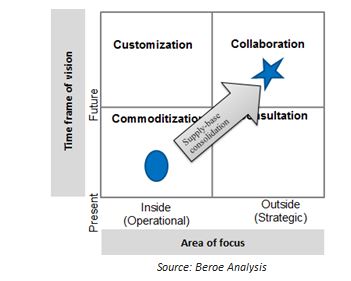
Moving buyer-supplier relationship to a collaborative level brings in mutual benefits

Abstract:
While large organizations may reduce their supplier count, they may have to depend on a few major service providers who can take charge of their facilities management requirements. This article tries to examine the relationship between the buyer and the service provider in this context.
The traditional contract and KPIs-based relationship is slowly expected to transform into a collaborative and flexible bond, with open channels of communication and shared investments. A collaborative partnership begins with an organizational-level mind set and vision. As organizations begin to treat their suppliers as partners, they can reap more than the expected savings and value.
Introduction:
The last decade has seen a shift in the way facilities services are being outsourced and buyers are beginning to realize the value of outsourcing higher volumes of services to a single service provider. Large buyers are moving towards procuring multiple services from a single service provider in order to reap the benefits of high volume outsourcing. This trend is noticed among Fortune 500 companies that look at consolidating their supply-base. As consolidation occurs and buyers depend on fewer service providers, an automatic need arises for a change in the engagement methods between the buyers and service providers. Their relationship changes with trust and sharing-based collaboration gaining prominence over transactions.
The relationship change:
When contracts are won at lower margins, and buyers focus on low cost contracts, it most prominently affects the relationship between the buyer and the vendor. The relationship becomes commoditized and can very easily be characterized by poor loyalty and unmet expectations. According to a survey by a popular online facilities management magazine, the loyalty between the buyer and the FM service provider is one of the lowest across all sectors.
Over the course of the contract period, the service provider looks forward to improve the margin and in this effort compromises on the quality of work delivered and neglects the need of the buyer, when ideally both the buyer and supplier must be collaborating to explore mechanisms to balance the cost, value and quality of services being delivered. It would be useful to explore the elements of how this relationship should evolve when buyers move towards consolidation of their supply base and want a strategic partner in achieving their facilities management goals.
Communication is the Key:
Technology is one of the key enablers of a collaborative relationship as it makes the process of communication simpler and easier. Particularly in facilities management, cloud-based applications which are easily accessible on-the-go in multiple systems including mobile devices are gaining prominence. A common platform for communication such as a building management system shared by the buyer and the vendor should be in place so that the stakeholders can have easy access to information and can communicate more effectively.
Bolder investment decisions:
When two parties are on a road to develop a long term partnership, the service provider brings his expertise with respect to the best practices in the industry on to the table. This makes the buyer more confident in sharing investments keeping in mind, interoperability and common platforms. The facilities management service provider of a large pharmaceutical company, under a long term partnership-based gain sharing agreement, had invested in high-tech building management system and an inter-operable IT system. This set up, in the long run, will help the buyer in terms of energy savings and better communication infrastructure.
Focus on Performance based KPIs:
Innovation in work practices and services offered is considered to be one of the key outcomes of a close buyer-service provider relationship. Therefore, setting traditional outcomes for defined tasks will hinder the very purpose of this relationship structuring process. Long term, performance based KPIs will be more suitable in building an air of trust in the relationship. For example, instead of measuring the frequency of complaints received for a particular service, KPIs can also be framed for measuring how frequently services are performed in an effort to prevent complaints.
Expect and be open to a dynamic contract:
The relationship between the buyer and the facilities management service provider can become viable only if both parties agree to accept that the working environment and demands will always be subject to changes. A flexible contract that balances the risk between the buyer and seller and clearly specifies the action items when the scope or specifications change should be in place. If the supplier works in a way where they charge a premium for every change in scope of work and the buyer remains rigid with respect to service delivery, the partnership will not work.
An example of having a flexible approach both by the buyer and service provider is established by EMCOR, UK, that had a collaborative partnering with its buyer - The Department of Health, UK. EMCOR took over as an integrated provider, replacing the numerous sub-contractors the buyer worked with on services ranging from hard and soft services to waste management. They cite the nature of their relationship as very critical to achieving 28 percent savings, exceeding their buyer’s savings target by 18 percent.
Conclusion:
The buyer-service provider engagement is witnessing a change with many service providers trying to add value to their services to stay ahead in the marketplace. Facilities service providers in mature markets like the UK are beginning to get certified with standards such as BS 11000 in order to portray themselves as collaborative service providers capable of adding value and achieving cost savings for the buyer. The acceptance of the concept of a collaborative approach with the service provider is very important when large organizations look forward to consolidating their facilities management supply base. Developing this long term vision will help the buyers to look beyond RFPs and quotations in choosing the right partner for the organization.
Related Insights:
View All
Get more stories like this
Subscirbe for more news,updates and insights from Beroe







